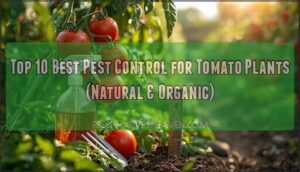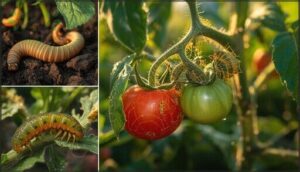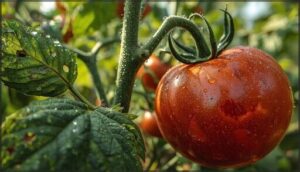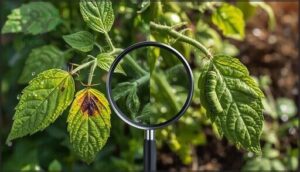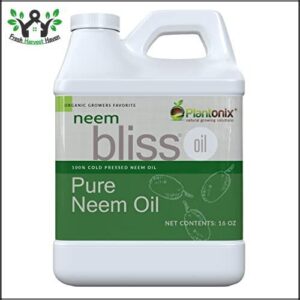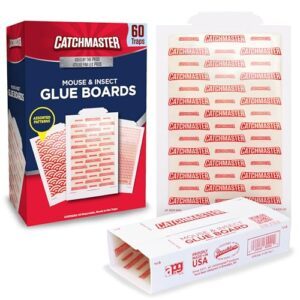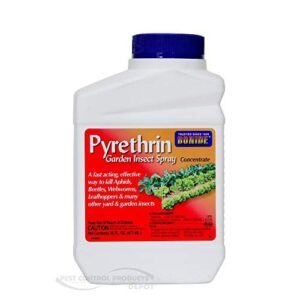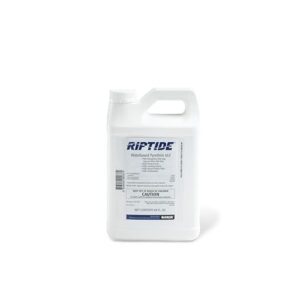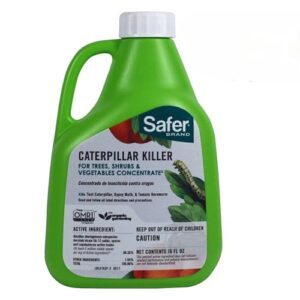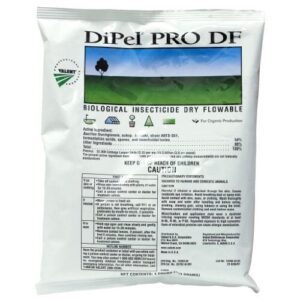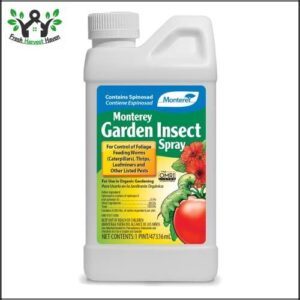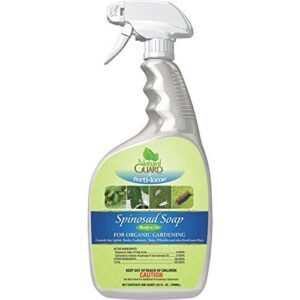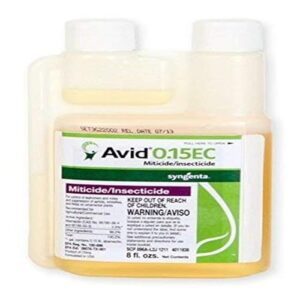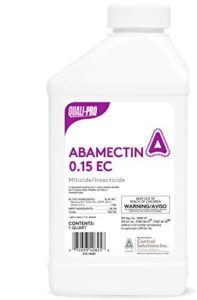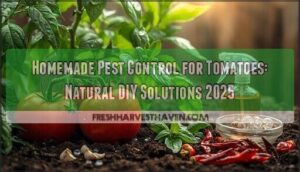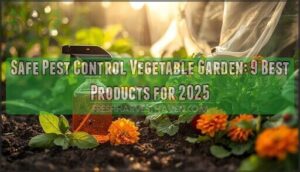This site is supported by our readers. We may earn a commission, at no cost to you, if you purchase through links.
Your tomato plants can lose up to 30% of their yield before you even notice a pest problem. Hornworms blend perfectly with foliage while devouring entire branches overnight, aphids multiply from a few stragglers to thousands in just weeks, and spider mites create near-invisible damage that compounds daily.
The challenge isn’t just identifying these invaders—it’s choosing control methods that protect your harvest without introducing harsh chemicals into your homegrown food. Natural and organic pest control products have proven their worth in field trials, with options like neem oil and spinosad delivering 30–50% effectiveness while keeping your tomatoes safe to eat.
This guide breaks down the top 10 organic solutions that actually work, from biological controls to targeted sprays, so you can match the right product to your specific pest challenge and protect your plants throughout the growing season.
Table Of Contents
- Key Takeaways
- Common Tomato Plant Pests and Their Damage
- Effective Pest Control Methods for Tomatoes
- Top 10 Pest Control Products for Tomato Plants
- 1. Neem Bliss Pure Neem Oil Concentrate
- 2. Catchmaster Mouse and Insect Glue Traps
- 3. Bonide Pyrethrin Garden Insect Spray
- 4. MGK Riptide Mosquito and Flying Insecticide
- 5. Safer Brand Caterpillar Killer Concentrate II
- 6. Valent Dipel Pro Biological Insecticide BT
- 7. Monterey Garden Insect Spray with Spinosad
- 8. Natural Guard Spinosad Insect Killer
- 9. Avid Miticide Insecticide Spider Mite Control
- 10. Quali Pro Abamectin Mite Control
- Promoting Natural and Organic Pest Control
- Seasonal Strategies for Tomato Pest Prevention
- Frequently Asked Questions (FAQs)
- Conclusion
Key Takeaways
- You can lose up to 30% of your tomato yield before noticing a pest problem, so weekly monitoring using sticky traps and visual checks catches infestations early and prevents up to 70% of potential crop loss.
- Natural pest control products like neem oil, spinosad, and Bacillus thuringiensis deliver 30-95% effectiveness against common tomato pests while keeping your harvest safe to eat, with many options approved for use up to harvest day.
- Integrated pest management combining hand-picking, beneficial insects like ladybugs and parasitic wasps, companion planting with basil or marigolds, and targeted organic sprays cuts insecticide use by 82% while boosting yields 6-8% and profits 45% over conventional methods.
- Timing your control measures to pest life cycles and using preventative practices like reflective mulch (which reduces thrips and viral diseases by 46%) and drip irrigation creates natural barriers that slash pest pressure by 42% throughout the growing season.
Common Tomato Plant Pests and Their Damage
Your tomato plants face threats from several common pests that can seriously damage your crop if you don’t catch them early. Each pest leaves behind distinct clues, from chewed leaves to wilted stems, that tell you exactly what you’re dealing with.
Let’s break down the most frequent culprits so you can spot them quickly and take action before they destroy your harvest.
Identifying Cutworms, Hornworms, Aphids, and Spider Mites
How do you spot the culprits attacking your tomatoes? Start by recognizing their distinct features. Cutworms curl into a “C” shape when disturbed and hide in soil by day, while hornworms display white V-markings and leave dark green frass near chewed leaves. One way to identify them is by the distinct horn on their tail.
Look for these key signs:
- Aphid honeydew creates sticky residue on foliage
- Mite webbing with stippling patterns appears as pale yellow specks
- Hornworm frass signals active feeding
Identifying tomato pests early protects your harvest.
Signs of Pest Damage on Leaves, Stems, and Fruit
Once you’ve identified the pests, recognizing signs of damage becomes your next step in pest identification. Leaf damage from flea beetles creates tiny 0.5 mm holes, while spider mites produce stippling and yellowing on upper surfaces.
Check stems for cankers or corky rings from tomato bugs.
Inspect fruit for stink bug pinpricks with discolored spots, thrips signs like small dimples, or fruit cavities from fruitworm feeding. You may also notice damage from tomato fruitworms, which are very damaging.
Differentiating Pest Issues From Diseases
Visual symptom overlap makes differentiating pest damage and diseases tricky—roughly 18% of leaf lesions get misdiagnosed. Look for tissue indicators: concentric rings suggest early blight, while irregular chewing points to caterpillars. Sophisticated diagnostics like AI differentiation tools achieve 96% accuracy in pest identification versus plant diseases. When infestation signs seem unclear, diagnostic misdiagnosis drops to 4% with expert lab analysis.
- Bacterial spots mimic fungal damage in 14% of cases
- Wilting with stiff leaves signals viral disease, not pests
- Water-soaked fruit areas need closer inspection for accurate diagnosis
Effective Pest Control Methods for Tomatoes
Once you’ve identified the pests attacking your tomato plants, you can take action to protect your crop. The good news is that you don’t need harsh chemicals to fight back—natural and organic methods work just as well, if not better.
Here are four proven approaches that will help you reclaim your garden without compromising safety or sustainability.
Hand-picking and Physical Removal
Hand-picking remains one of your most reliable tools against large, visible pests like tomato hornworms and Colorado potato beetles. You’ll achieve up to 87% success when you inspect daily, removing caterpillars and egg masses before they multiply. This physical intervention—especially during early morning or evening—preserves fruit quality and boosts marketable yield by 30% in home gardens, though it’s less practical for tiny, fast-moving pests.
| Pest Type | Hand-Picking Effectiveness |
|---|---|
| Tomato Hornworms | 70%+ damage reduction |
| Cutworms | 80% population control |
| Aphids | Below 30% effectiveness |
| Colorado Potato Beetles | Highly effective when consistent |
While manual removal success shines in small plots, hand-picking limitations emerge at commercial scale or with rapid breeders. For best results, pair this method with integrated pest management strategies that address your garden’s full pest spectrum and yield quality impact goals.
Use of Insecticidal Soaps and Horticultural Oils
When aphids, spider mites, or whiteflies invade, insecticidal soaps and horticultural oils deliver 30–50% field efficacy through direct contact. Application rates of 2–3% soap or 0.5–2% oil control soft-bodied pests effectively, but phytotoxicity risks increase above 88°F—tomatoes show leaf burn at higher concentrations.
Their limited pest spectrum and resistance issues make IPM integration essential for complete organic pest control methods.
Biological Controls (Bt, Beneficial Insects)
Because biological control harnesses natural predators, you gain lasting pest suppression without chemicals.
Bacillus thuringiensis delivers 29% fruit infestation reduction targeting caterpillars, while ladybug releases—1 per square foot—tackle aphids efficiently. Parasitic wasps achieve 85% aphid suppression through wasp parasitism, and lacewing predation eliminates 200 aphids daily per larva.
Predatory mites reduce spider mite populations by 95% with weekly applications, making beneficial insects your frontline defense.
Preventive Measures (row Covers, Crop Rotation, Sanitation)
Beyond active control, pest prevention builds your strongest defense. You’ll achieve up to 74% infestation control with row covers installed at planting, sealing edges to form natural barriers. Rotate tomato crops for three years minimum—this measure’s effectiveness cuts pest populations by over 70%.
Sanitize tools between plants, reducing disease transmission by 60%, and you’ll realize economic impacts including 20-30% lower pesticide costs while implementing organic pest control strategies that sustain long-term garden health.
Top 10 Pest Control Products for Tomato Plants
You’ve got plenty of options for protecting your tomato plants from pests without relying on harsh chemicals. The products below range from natural oils and biological controls to targeted sprays that work with your organic gardening approach.
Each one addresses specific pest problems, so you can choose what fits your garden’s needs best.
1. Neem Bliss Pure Neem Oil Concentrate
You’re in control when you choose Neem Bliss Pure Neem Oil Concentrate for organic pest control. This natural insecticide combats tomato pests like aphids, spider mites, and hornworms by disrupting their feeding and reproduction.
Application guidelines recommend mixing 1-2 tablespoons per gallon of water, spraying every 7-14 days during early morning or evening. Its safety profile and environmental impact make it ideal for chemical-free gardens.
Consumer insights confirm its effectiveness, and studies show up to 90% reduction in pest activity, giving you mastery over your tomato plants.
Best For: Organic gardeners and tomato growers seeking a natural, chemical-free solution to control common pests like aphids, spider mites, and whiteflies without harming beneficial insects.
- Highly effective against a wide range of tomato pests, with studies showing up to 90% reduction in pest activity when applied consistently every 7-14 days.
- OMRI-listed for organic use and safe for the environment, biodegrading quickly without contaminating soil or water while posing minimal risk to pollinators and beneficial insects.
- Cost-effective due to high concentration—only 1-2 tablespoons per gallon needed—and also provides fungicidal benefits against diseases like powdery mildew and early blight.
- Requires regular reapplication every 1-2 weeks since the active compounds degrade quickly in sunlight, making it more labor-intensive than some synthetic alternatives.
- Has a strong, unpleasant odor that many users find off-putting, and the oil may solidify in cold temperatures, requiring warming before use.
- Must be applied during early morning or late evening to avoid leaf burn, and can cause mild skin irritation in sensitive individuals, so protective gloves are recommended.
2. Catchmaster Mouse and Insect Glue Traps
Sticky traps mightn’t be the first thing you think of for natural pest control, but Catchmaster Mouse and Insect Glue Traps deliver impressive results in tomato gardens. These pesticide-free boards capture whiteflies, aphids, thrips, and fungus gnats instantly upon contact, supporting organic pest control strategies without chemical residues.
Glue trap efficacy studies show they catch four times more insects than competing products. For safe usage, place traps near plant stems or along walls, checking monthly during the growing season.
At roughly $0.40–$1.00 per unit, this cost analysis reveals an economical pest control strategy with minimal environmental impact.
Best For: Tomato growers seeking an affordable, pesticide-free way to monitor and reduce flying pests like whiteflies, aphids, and thrips without introducing chemicals into their soil or fruit.
- Captures up to four times more insects than competing glue traps, making them highly effective for controlling common tomato pests like whiteflies, aphids, and fungus gnats.
- Pesticide-free and non-toxic formula supports organic gardening standards and keeps chemical residues away from your tomato plants and fruit.
- Long-lasting effectiveness for up to 12 months and economical pricing at $0.40–$1.00 per trap make them a budget-friendly solution for season-long pest management.
- Mixed reviews on adhesive strength suggest some traps may not hold larger pests like mice as reliably as smaller insects.
- Strong scent can be off-putting to some users, even though it’s designed to attract pests with a peanut butter aroma.
- Requires monthly checking and replacement during peak growing season to maintain optimal performance, adding a maintenance task to your gardening routine.
3. Bonide Pyrethrin Garden Insect Spray
When pyrethrin-based sprays contact aphids, beetles, or hornworms on your tomato foliage, the botanical extract disrupts their nervous systems within hours. Bonide Pyrethrin Garden Insect Spray delivers natural insecticides derived from chrysanthemum flowers, offering organic pest control that’s safe up to harvest day.
Mix 3–5 tablespoons per gallon and apply with a hand sprayer for complete coverage. Pyrethrin effectiveness shines through rapid biodegradation—residues vanish within days, minimizing environmental impact.
While residue concerns remain low, proper application methods and dilution ratios help you protect both plants and beneficial insects when spraying at dusk.
Best For: Organic gardeners who need fast-acting, naturally derived pest control on tomatoes and vegetables with minimal wait time before harvest.
- Kills a wide range of common tomato pests (aphids, hornworms, beetles, whiteflies) on contact within hours through nervous system disruption.
- Safe to use up to harvest day with minimal residue concerns due to rapid breakdown under sunlight and low mammalian toxicity.
- Low environmental impact with quick biodegradation that protects beneficial insects when applied at dusk and limits soil or water contamination.
- Requires repeat applications every 7–10 days during peak pest activity since pyrethrin doesn’t provide long-lasting residual protection.
- Unpleasant odor reported by users that may be off-putting during mixing and application in garden settings.
- Proper dilution and careful timing are essential to avoid skin irritation and minimize any potential impact on pollinators if sprayed during active hours.
4. MGK Riptide Mosquito and Flying Insecticide
MGK Riptide blends 5% pyrethrins with 25% piperonyl butoxide (PBO), creating a powerful synergism that inhibits detoxification enzymes in aphids and flying pests targeting your tomato plants.
You’ll mix one fluid ounce per 1,000 cubic feet or integrate it into automatic misting systems for consistent pest control solutions. Application methods include ULV foggers and backpack sprayers, delivering knockdown within an hour.
While pyrethrin efficacy remains strong and regulatory compliance meets EPA standards, this insecticide’s environmental impact concerns aquatic organisms—apply carefully to avoid runoff near water sources.
Best For: Homeowners and gardeners dealing with persistent mosquito, fly, or aphid problems who want fast-acting control and are comfortable managing automatic misting systems or foggers.
- Knocks down flying insects within an hour using plant-derived pyrethrins enhanced with PBO synergist for maximum effectiveness.
- Works with multiple application methods including automatic misting systems, ULV foggers, and backpack sprayers for flexible pest management.
- Low human toxicity rating (EPA Category IV) with reversible eye irritation and minimal skin concerns when used as directed.
- No residual protection after drying—only kills pests on contact during application, requiring frequent reapplication for ongoing control.
- Poses risks to aquatic life from runoff, so you’ll need to carefully avoid spraying near ponds, streams, or other water sources.
- Not available in New York and Connecticut due to state restrictions, and costs more than many competing insecticide products.
5. Safer Brand Caterpillar Killer Concentrate II
When caterpillars threaten your crop, Safer Brand Caterpillar Killer Concentrate II offers targeted organic pest control without harming beneficial insects. This natural insecticide contains 98.35% Bacillus thuringiensis, which stops caterpillars from feeding within hours of contact—Bt efficacy reaches 95% reduction after two applications.
Mix 1 tablespoon per gallon and spray during the late afternoon, since sunlight breaks down the active ingredient. Application guidelines recommend reapplying every 5 to 7 days.
You’ll appreciate the environmental safety profile: it’s OMRI Listed for organic gardening and safe to use even on harvest day.
Best For: Organic gardeners dealing with caterpillar infestations on tomatoes and vegetables who want effective pest control without harming pollinators or beneficial insects.
- Achieves up to 95% reduction in caterpillar populations after just two applications, with feeding stopping within hours of contact.
- OMRI Listed for organic gardening and safe to use right up to harvest day, with no harm to bees, birds, or earthworms.
- Easy to mix at 1 tablespoon per gallon and provides good coverage at about 1,000 square feet per batch.
- Breaks down quickly in sunlight, requiring late afternoon application and reapplication after rain every 5-7 days.
- Only works on actively feeding caterpillars, so timing and thorough leaf coverage (top and bottom) are critical for effectiveness.
- May not completely eliminate heavy hornworm infestations on the first try, especially on larger caterpillars.
6. Valent Dipel Pro Biological Insecticide BT
For broader pest spectrum control, Valent Dipel Pro delivers consistent results against hornworms, cutworms, armyworms, and over 30 caterpillar species. This biological control contains 54% Bacillus thuringiensis (Btk), offering OMRI-listed organic approval and resistance management benefits—you won’t face cross-resistance issues even after decades of use.
Mix 2 teaspoons per gallon to cover 1,000 square feet, reapplying every 5-7 days. The natural insecticide breaks down within 3-4 days in sunlight, but its organic pest control efficacy remains strong with proper application rates during active feeding periods.
Best For: Organic gardeners and farmers who need broad-spectrum caterpillar control with zero harvest restrictions and no risk of pest resistance.
- Targets over 30 caterpillar species including hornworms, cutworms, and armyworms with 54% Btk concentration and OMRI-listed organic certification.
- Zero-day pre-harvest interval means you can spray and harvest immediately, with only a 4-hour re-entry period for workers.
- No cross-resistance development after nearly 50 years of use, making it reliable for long-term pest management programs.
- Breaks down in sunlight within 3-4 days, requiring reapplication every 5-7 days to maintain protection.
- Only effective against actively feeding caterpillars—won’t work on other common pests like aphids, whiteflies, or fungus gnats.
- Results aren’t instant like chemical pesticides; larvae stop feeding quickly but mortality takes 1-3 days to occur.
7. Monterey Garden Insect Spray with Spinosad
When quick action matters, Monterey Garden Insect Spray targets leafminers, thrips, and caterpillars using 0.5% spinosad, a nerve and stomach poison derived from soil bacteria.
Mix 2 ounces per gallon and apply every 7 days, stopping 1 day before harvest for vegetables. This OMRI-listed insecticide kills feeding pests within 24-48 hours while sparing ladybugs and lacewings when spray residues dry.
Rotate spinosad with other controls to prevent resistance development, and avoid spraying blooming plants to protect foraging bees.
Best For: Home gardeners dealing with caterpillars, leafminers, or thrips who want an organic-approved solution that works fast without harming beneficial insects.
- Kills a wide range of pests within 24-48 hours while being safe for ladybugs, lacewings, and other beneficial insects once dried.
- OMRI-listed for organic gardening with a short pre-harvest interval of just 1 day for most vegetables.
- Easy to mix and apply with any standard sprayer, making it accessible for gardeners at any skill level.
- Toxic to bees if they contact wet spray, so you need to avoid blooming plants and time applications carefully.
- Requires the pest to ingest it rather than working on contact, which means it’s not an instant knockdown solution.
- Can build up resistance in pests over time, requiring rotation with other control methods to maintain effectiveness.
8. Natural Guard Spinosad Insect Killer
For fast-acting control without synthetic chemicals, Natural Guard Spinosad Insect Killer delivers 0.5% spinosad in a ready-to-spray 32-ounce bottle. This natural insecticide stops armyworms, hornworms, and thrips from feeding within hours, protecting up to 5,300 square feet of your tomato plants.
Spray every 7-14 days, rotating with other organic pest control methods to prevent resistance buildup. While it’s practically non-toxic to earthworms and birds, avoid spraying during bloom since it affects bees for 3 hours after application.
Best For: Organic gardeners who need fast-acting pest control on vegetables and ornamentals without using synthetic chemicals.
- Kills caterpillars, thrips, and leafminers within hours while remaining safe for earthworms and birds
- OMRI-listed for organic gardening with coverage up to 5,300 square feet per bottle
- Ready-to-spray formula requires no mixing or measuring
- Resistance can develop quickly in pests like tomato borers, requiring rotation with other control methods
- Toxic to bees for up to 3 hours after spraying, limiting application timing during bloom
- Some users report leaky spray nozzles that may require transferring to a different sprayer
9. Avid Miticide Insecticide Spider Mite Control
When spider mites ravage your greenhouse tomato plants, Avid Miticide Insecticide delivers abamectin efficacy through its 19 g/L concentration. This miticide penetrates leaf surfaces for residual activity up to 28 days, controlling mites and leafminers with applications every 7-10 days.
You’ll need protective gear since application safety requires careful handling, and environmental impact concerns mean keeping it away from bees and fish. Resistance management demands rotating with different mode-of-action products, limiting you to 2 consecutive applications.
It’s approved specifically for greenhouse use, not outdoor tomato crops.
Best For: Greenhouse tomato growers who need strong, long-lasting control of spider mites and leafminers, especially where resistance to other products is a problem.
- Delivers up to 28 days of residual control after each application
- Highly effective against spider mites, leafminers, and certain psyllids
- Works quickly, stopping pest feeding within hours
- Requires careful handling and protective gear due to toxicity
- Not suitable for use on flowering or consumable plants
- Can be expensive compared to other pest control options
10. Quali Pro Abamectin Mite Control
For controlling tomato pests like spider mites and leafminers, Quali-Pro Abamectin 0.15 EC offers outstanding abamectin effectiveness at 8-16 fluid ounces per acre. This insecticide provides translaminar movement through leaves, killing pests on both surfaces while boosting plant vigor.
You’ll apply it every 7 days following application guidelines, rotating with different insecticide categories for resistance management. Safety concerns include moderate eye irritation and toxicity to bees, requiring protective gear.
Regulatory compliance demands adherence to maximum residue limits and 12-hour reentry intervals, making proper dosing essential for this concentrated insecticide recommendation.
Best For: Growers dealing with heavy spider mite or leafminer infestations on tomatoes and ornamentals who need fast-acting control with residual protection.
- Kills mites on both sides of leaves thanks to translaminar movement, reaching pests you can’t spray directly while improving plant health and vigor.
- Controls multiple pests including spider mites, leafminers, and root-knot nematodes, plus suppresses aphids, thrips, and whiteflies for broader protection.
- Unique mode of action (IRAC Group 6) makes it valuable for rotating with other products to prevent resistance while fitting into IPM programs.
- Requires weekly reapplication and tank mixing with other miticides when populations are high, increasing time and cost compared to longer-lasting options.
- Highly toxic to bees and aquatic life with strict environmental precautions, limiting when and where you can safely apply it.
- Concentrated formula demands precise dilution and protective equipment due to moderate eye and skin irritation risks.
Promoting Natural and Organic Pest Control
Natural and organic pest control methods protect your tomato plants without harming the environment or your health. These approaches work with nature rather than against it, creating a balanced garden ecosystem that keeps pests in check.
Here are four key strategies you can use to maintain healthy tomato plants while avoiding synthetic chemicals.
Attracting and Protecting Beneficial Insects
You can turn your tomato patch into a haven for beneficial insects like ladybugs and parasitic wasps, the natural enemies that keep pest populations in check. Shelter plants such as buckwheat, basil, and sunflowers planted every ten rows boost natural predators by creating habitat.
IPM strategies that avoid broad-spectrum pesticides protect these allies, delivering economic benefits through reduced chemical use and healthier yields.
Companion Planting for Pest Prevention
Strategic companion plants work like bodyguards for your tomatoes, releasing VOC pest disruption signals that confuse and repel invaders. Here’s what you should plant:
- Basil reduces hornworms by 52% while enhancing your tomato’s natural defenses by 32%
- Marigold slashes whitefly populations by 40% and nematodes by up to 70%
- Nasturtiums function as trap cropping efficacy heroes, luring aphids away
Companion plant diversity with three or more species maximizes beneficial insect attraction and delivers yield increase factors of 20-35%.
Organic Sprays and Homemade Remedies
You can protect your tomatoes with simple homemade remedies that work. Neem oil at 2% concentration cuts pest injury by 37%, while insecticidal soap mixed with one tablespoon per quart reduces aphids and spider mites within 7–14 days. Chili garlic sprays lower caterpillars by 33%.
These natural insecticides cost under $2 per 100 plants, proving spray efficacy without chemicals. Adoption rates climb 15% yearly as organic gardening gains momentum.
Implementing Integrated Pest Management (IPM)
Beyond quick fixes, integrated pest management combines organic pest control with smart planning. You’ll scout weekly using sticky traps and visual checks, identifying pests before they explode. Cultural practices like crop rotation and mulching create hostile ground for invaders, while beneficial insects patrol your plants. This pest control strategy for tomatoes cuts insecticide use by 82% and boosts profits 45% over conventional methods.
Integrated pest management slashes insecticide use by 82% through weekly scouting, crop rotation, and beneficial insects—boosting profits 45% over conventional methods
IPM benefits that transform your garden:
- Your tomato yield jumps 6–8% as pest pressure drops and plant health improves
- Scouting methods catch problems early, saving you money on unnecessary treatments
- Biological control agents like ladybugs work around the clock protecting your investment
- Cultural practices build long-term resistance, not just temporary relief
- Economic impact favors your wallet with benefit-cost ratios reaching 2.41 versus 1.44 without IPM
Seasonal Strategies for Tomato Pest Prevention
Protecting your tomato plants from pests isn’t a one-time effort—it requires different approaches as the seasons change. Understanding when pests are most active and adjusting your practices accordingly keeps your plants healthier throughout the year.
Here are three seasonal strategies that help you stay one step ahead of common tomato pests.
Monitoring and Maintenance Throughout The Growing Season
Throughout the growing season, you’ll want to check your tomato plants weekly for infestation signs. Early detection through careful pest scouting can prevent up to 70% of yield loss.
Keep a simple log tracking pest population numbers, weather patterns, and climatic correlations. Combine monitoring and maintenance practices like mulching and proper watering schedules with preventative measures.
Data technology like sticky traps helps you spot problems before they spiral out of control.
Adjusting Control Measures Based on Pest Life Cycles
After monitoring your plants, you need to sync your pest management with each pest’s life cycle. Pest generation intervals guide when to intervene—some complete their lifecycle in just seven days during summer heat. Temperature-dependent lifecycle patterns demand adaptive seasonal strategies:
- Apply natural insecticides during early larval stages for maximum impact
- Release beneficial insects ten days after spotting adult pests
- Rotate organic pest control methods targeting different life stages
- Deploy pheromone traps at the start of new pest generations
This lifecycle-based IPM approach keeps populations in check year-round.
Mulching and Watering Practices to Deter Pests
Your mulching and watering choices create natural barriers against pests. Reflective silver mulch reduces thrips and viral diseases by up to 46%, while drip irrigation cuts fungal issues by 15–22% compared to overhead watering.
Here’s how different mulch types compare for pest suppression:
| Mulch Type | Pest Reduction |
|---|---|
| Silver reflective | 35–50% virus transmission decrease |
| Black polyethylene | 30% improved yields, weed control |
| Organic (hay, straw) | 23% pest population reduction |
| UV-reflective | 45% fewer virus-infected plants |
| Living mulches | Mixed results, monitor beneficial insects |
Combine plastic mulching with drip irrigation for integrated strategies that slash pest pressure by 42% while boosting plant health and water efficiency.
Frequently Asked Questions (FAQs)
When should I start pest prevention measures?
Don’t let pests get the jump on your tomatoes. Start pest prevention timing and early intervention immediately after transplanting.
Regular pest monitoring and preventative measures throughout the season keep natural pest control effective.
Can I reuse soil from infested plants?
You shouldn’t reuse infested soil without proper treatment. Tomato pests like hornworms survive three weeks in soil, while pathogens causing early blight persist for years.
Soil sterilization through solarization or heat treatment removes harmful organisms before safe soil reuse.
How do weather conditions affect pest populations?
Picture a garden scorched by summer heat or drenched after storms—weather conditions dramatically reshape pest populations. Temperature fluctuations, humidity effects, drought impacts, wind dispersal, and extreme weather all influence natural pest control effectiveness and environmental conditions surrounding your plants.
Are chemical pesticides safe for edible tomatoes?
Chemical pesticides can harm human health and the environment through residue accumulation and toxicity levels. While regulatory compliance ensures most residues stay below limits, organic pest control and natural pesticides offer safer alternatives for edible tomatoes.
What pests attack indoor tomato plants differently?
An ounce of prevention beats a pound of cure”—especially indoors. Indoor tomato plants face aphids, whiteflies, spider mites, and fungus gnats more severely.
Greenhouse infestations escalate faster due to stable warmth, limited beneficial insects, and rapid pest growth unchecked by natural predators.
Conclusion
Ironically, the “pests” threatening your tomatoes are just hungry insects doing what nature programmed them to do—while you’re doing the same, protecting your food supply. The best pest control for tomato plants doesn’t require a chemistry degree or toxic warfare.
Hand-picking, neem oil, spinosad, and beneficial insects give you real solutions that work with nature’s design, not against it. Your harvest stays clean, your garden stays balanced, and those hornworms find dinner elsewhere.
- https://pmc.ncbi.nlm.nih.gov/articles/PMC7797375/
- https://croplifefoundation.wordpress.com/wp-content/uploads/2012/07/combined_document_tomato.pdf
- https://bioengineer.org/sustainable-biorational-pesticides-for-tomato-pest-control/
- https://www.novobac.com/blog/biological-pest-control-in-greenhouse-tomatoes/
- https://apsjournals.apsnet.org/doi/10.1094/PHP-09-21-0123-RS

